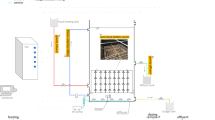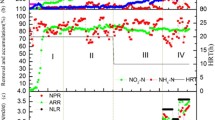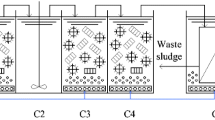Abstract
The effects of biological factors including dissolved oxygen (DO), pH, carbon/nitrogen (C/N) and hydraulic retention times (HRT) on the performance of simultaneous nitrification and denitrification (SND) in a moving bed sequencing batch reactor (MBSBR) were investigated. A low DO was found to be advantageous to the SND in that nitrification was not inhibited, while pH and C/N ratio were shown to have positive effects on SND, and HRT needed to be controlled in a suitable range. A desirable SND efficiency was obtained at a DO of 2.5 mg L−1, pH of approximately 8.0, C/N ratio of 10 and HRT of 10 h in the MBSBR. High-throughput sequencing analysis showed that different operating conditions impacted microbial communities, resulting in different nitrogen removal mechanisms. Autotrophic and heterotrophic nitrification together contributed to the good nitrification performance, while denitrification was conducted by combined anoxic and aerobic processes. Furthermore, the results of principal component analyses (PCA) and the abundance of the predominant nitrification and denitrification genera both showed that DO and HRT might be regarded as the dominant variable factors influencing community structure analysis during SND, while the linear discriminant analysis (LDA) effect size (LEfSe) algorithm showed differences in abundance among the biofilm microbial communities with different DO. Overall, the results of this study improve our understanding of the bacterial community structure with different operating conditions in MBSBRs.








Similar content being viewed by others
References
He SB, Xue G, Wang BZ (2009) Factors affecting simultaneous nitrification and de-nitrification (SND) and its kinetics model in membrane bioreactor. J Hazard Mater 168:704–710
Li L, Dong Y, Qian G, Hu X, Ye L (2018) Performance and microbial community analysis of bio-electrocoagulation on simultaneous nitrification and denitrification in submerged membrane bioreactor at limited dissolved oxygen. Bioresour Technol 258:168–176
Blázquez E, Gabriel D, Baeza JA, Guisasola A (2017) Evaluation of key parameters on simultaneous sulfate reduction and sulfide oxidation in an autotrophic biocathode. Water Res 123:301–310
Zhao J, Feng L, Yang G, Dai J, Mu J (2017) Development of simultaneous nitrification-denitrification (SND) in biofilm reactors with partially coupled a novel biodegradable carrier for nitrogen-rich water purification. Bioresour Technol [Internet] 243:800–809. https://doi.org/10.1016/j.biortech.2017.06.127
Cao Y, Zhang C, Rong H, Zheng G, Zhao L (2017) The effect of dissolved oxygen concentration (DO) on oxygen diffusion and bacterial community structure in moving bed sequencing batch reactor (MBSBR). Water Res 108:86–94
Young B, Banihashemi B, Forrest D, Kennedy K, Stintzi A, Delatolla R (2016) Meso and micro-scale response of post carbon removal nitrifying MBBR biofilm across carrier type and loading. Water Res [Internet] 91:235–243. https://doi.org/10.1016/j.watres.2016.01.006
Hwang CC, Weng CH (2017) Key factors contributing to simultaneous nitrification-denitrification in a biological aerated filter system using oyster shell medium. Environ Prot Eng 43:75–86
Xue J, Zhang Y, Liu Y, Gamal El-Din M (2016) Treatment of oil sands process-affected water (OSPW) using a membrane bioreactor with a submerged flat-sheet ceramic microfiltration membrane. Water Res [Internet] 88:1–11. https://doi.org/10.1016/j.watres.2015.09.051
Vinet L, Zhedanov A (2010) A “missing” family of classical orthogonal polynomials. J Phys A Math Theor 44:085201
Sun X, Zhang H, Cheng Z, Wang S (2017) Effect of low aeration rate on simultaneous nitrification and denitrification in an intermittent aeration aged refuse bioreactor treating leachate. Waste Manag 63:410–416
Zhang S, Zhou Z, Li Y, Meng F (2018) Deciphering the core fouling-causing microbiota in a membrane bioreactor: low abundance but important roles. Chemosphere 195:108–118
Wang C, Liu S, Xu X, Guo Y, Yang F, Wang D (2018) Role of cyclic diguanylate in affecting microbial community shifts at different pH during the operation of simultaneous partial nitrification, anammox and denitrification process. Sci Total Environ [Internet] 637–638:155–162. https://doi.org/10.1016/j.scitotenv.2018.05.015
Quince C, Lanzén A, Curtis TP et al (2009) Accurate determination of microbial diversity from 454 pyrosequencing data. Nat Methods 6:639–641
Zhu Y, Xu J, Cao X, Cheng Y, Zhu T (2018) Characterization of functional microbial communities involved in diazo dyes decolorization and mineralization stages. Int Biodeterior Biodegrad 132:166–177
Segata N, Izard J, Waldron L et al (2011) Metagenomic biomarker discovery and explanation. Genome Biol 12:R60
Gao Y, Wang C, Zhang W, Di P, Yi N, Chen C (2017) Vertical and horizontal assemblage patterns of bacterial communities in a eutrophic river receiving domestic wastewater in southeast China. Environ Pollut 230:469–478
Meyer RL, Zeng RJ, Giugliano V, Blackall LL (2005) Challenges for simultaneous nitrification, denitrification, and phosphorus removal in microbial aggregates: mass transfer limitation and nitrous oxide production. FEMS Microbiol Ecol 52:329–338
Ma W, Han Y, Ma W et al (2017) Enhanced nitrogen removal from coal gasification wastewater by simultaneous nitrification and denitrification (SND) in an oxygen-limited aeration sequencing batch biofilm reactor. Bioresour Technol 244:84–91
Wang J, Rong H, Zhang C (2018) Evaluation of the impact of dissolved oxygen concentration on biofilm microbial community in sequencing batch biofilm reactor. J Biosci Bioeng [Internet] 125:532–542. https://doi.org/10.1016/j.jbiosc.2017.11.007
Zhang Y, Wang X, Hu M, Li P (2015) Effect of hydraulic retention time (HRT) on the biodegradation of trichloroethylene wastewater and anaerobic bacterial community in the UASB reactor. Appl Microbiol Biotechnol 99:1977–1987
Nielsen PH, Mielczarek AT, Kragelund C et al (2010) A conceptual ecosystem model of microbial communities in enhanced biological phosphorus removal plants. Water Res 44:5070–5088
Kindaichi T, Yamaoka S, Uehara R et al (2016) Phylogenetic diversity and ecophysiology of Candidate phylum Saccharibacteria in activated sludge. FEMS Microbiol Ecol 92:1–11
Guadie A, Xia S, Zhang Z et al (2014) Effect of intermittent aeration cycle on nutrient removal and microbial community in a fluidized bed reactor-membrane bioreactor combo system. Bioresour Technol 156:195–205
Lv XM, Shao MF, Li J, Li CL (2015) Metagenomic analysis of the sludge microbial community in a lab-scale denitrifying phosphorus removal reactor. Appl Biochem Biotechnol 175:3258–3270
Zekker I, Rikmann E, Tenno T et al (2015) Nitric oxide for anammox recovery in a nitrite-inhibited deammonification system. Environ Technol (United Kingdom) 36:2477–2487
Babbin AR, Jayakumar A, Ward BB (2016) Organic matter loading modifies the microbial community responsible for nitrogen loss in estuarine sediments. Microb Ecol 71:555–565
Wang J, Zhang C, Rong H (2014) Analysis and succession of nitrifying bacteria community structure in sequencing biofilm batch reactor. Appl Microbiol Biotechnol 98:4581–4587
Wang J, Gong B, Wang Y, Wen Y, Zhou J, He Q (2017) The potential multiple mechanisms and microbial communities in simultaneous nitrification and denitrification process treating high carbon and nitrogen concentration saline wastewater. Bioresour Technol [Internet] 243:708–715. https://doi.org/10.1016/j.biortech.2017.06.131
Van Der Meer MTJ, Schouten S, Damsté JSS, Ward DM (2007) Impact of carbon metabolism on 13C signatures of cyanobacteria and green non-sulfur-like bacteria inhabiting a microbial mat from an alkaline siliceous hot spring in Yellowstone National Park (USA). Environ Microbiol 9:482–491
Gaisin VA, Grouzdev DS, Namsaraev ZB, Sukhacheva MV, Gorlenko VM, Kuznetsov BB (2016) Biogeography of thermophilic phototrophic bacteria belonging to Roseiflexus genus. FEMS Microbiol Ecol 92:f1w012
Seviour TW, Lambert LK, Pijuan M, Yuan Z (2011) Selectively inducing the synthesis of a key structural exopolysaccharide in aerobic granules by enriching for Candidatus “competibacter phosphatis”. Appl Microbiol Biotechnol 92:1297–1305
Meyer RL, Saunders AM, Zeng RJ, Keller J, Blackall LL (2003) Microscale structure and function of anaerobic–aerobic granules containing glycogen accumulating organisms. FEMS Microbiol Ecol 45:253–261
Jiang B, Du C, Shi S et al (2017) Enhanced treatment performance of coking wastewater and reduced membrane fouling using a novel EMBR. Bioresour Technol 229:39–45
Li C, Yang J, Wang X et al (2015) Removal of nitrogen by heterotrophic nitrification-aerobic denitrification of a phosphate accumulating bacterium Pseudomonas stutzeri YG-24. Bioresour Technol 182:18–25
Zhang J, Wu P, Hao B, Yu Z (2011) Heterotrophic nitrification and aerobic denitrification by the bacterium Pseudomonas stutzeri YZN-001. Bioresour Technol 102:9866–9869
Zhao J, Huang J, Guan M, Zhao Y, Chen G, Tian X (2016) Mathematical simulating the process of aerobic granular sludge treating high carbon and nitrogen concentration wastewater. Chem Eng J 306:676–684
Vijayalayan P, Thanh BX, Visvanathan C (2014) Simultaneous nitrification denitrification in a batch granulation membrane airlift bioreactor. Int Biodeterior Biodegrad 95:139–143
Gerbersdorf SU, Wieprecht S (2015) Biostabilization of cohesive sediments: revisiting the role of abiotic conditions, physiology and diversity of microbes, polymeric secretion, and biofilm architecture. Geobiology 13:68–97
Richards AM, Abu Kwaik Y, Lamont RJ (2015) Code blue: Acinetobacter baumannii, a nosocomial pathogen with a role in the oral cavity. Mol Oral Microbiol 30:2–15
Ontiveros-Valencia A, Tang Y, Zhao HP et al (2014) Pyrosequencing analysis yields comprehensive assessment of microbial communities in pilot-scale two-stage membrane biofilm reactors. Environ Sci Technol 48:7511–7518
Yang Q, Zhao H, Du B (2017) Bacteria and bacteriophage communities in bulking and non-bulking activated sludge in full-scale municipal wastewater treatment systems. Biochem Eng J [Internet] 119:101–111. https://doi.org/10.1016/j.bej.2016.12.017
Banerjee S, Baah-Acheamfour M, Carlyle CN et al (2016) Determinants of bacterial communities in Canadian agroforestry systems. Environ Microbiol 18:1805–1816
Acknowledgements
This work was supported by the National Natural Science Foundation of China (Grant no. 51778155) and the Natural Science Foundation of Guangdong Province (no. 2017A030313310). We thank Jeremy Kamen, M.Sc, from Liwen Bianji, Edanz Group China (www.liwenbianji.cn/ac), for editing the English text of a draft of this manuscript.
Author information
Authors and Affiliations
Corresponding author
Ethics declarations
Conflict of interest
The authors declare that they have no conflict of interest.
Additional information
Publisher's Note
Springer Nature remains neutral with regard to jurisdictional claims in published maps and institutional affiliations.
Electronic supplementary material
Below is the link to the electronic supplementary material.
Rights and permissions
About this article
Cite this article
Wang, J., Rong, H., Cao, Y. et al. Factors affecting simultaneous nitrification and denitrification (SND) in a moving bed sequencing batch reactor (MBSBR) system as revealed by microbial community structures. Bioprocess Biosyst Eng 43, 1833–1846 (2020). https://doi.org/10.1007/s00449-020-02374-w
Received:
Accepted:
Published:
Issue Date:
DOI: https://doi.org/10.1007/s00449-020-02374-w




